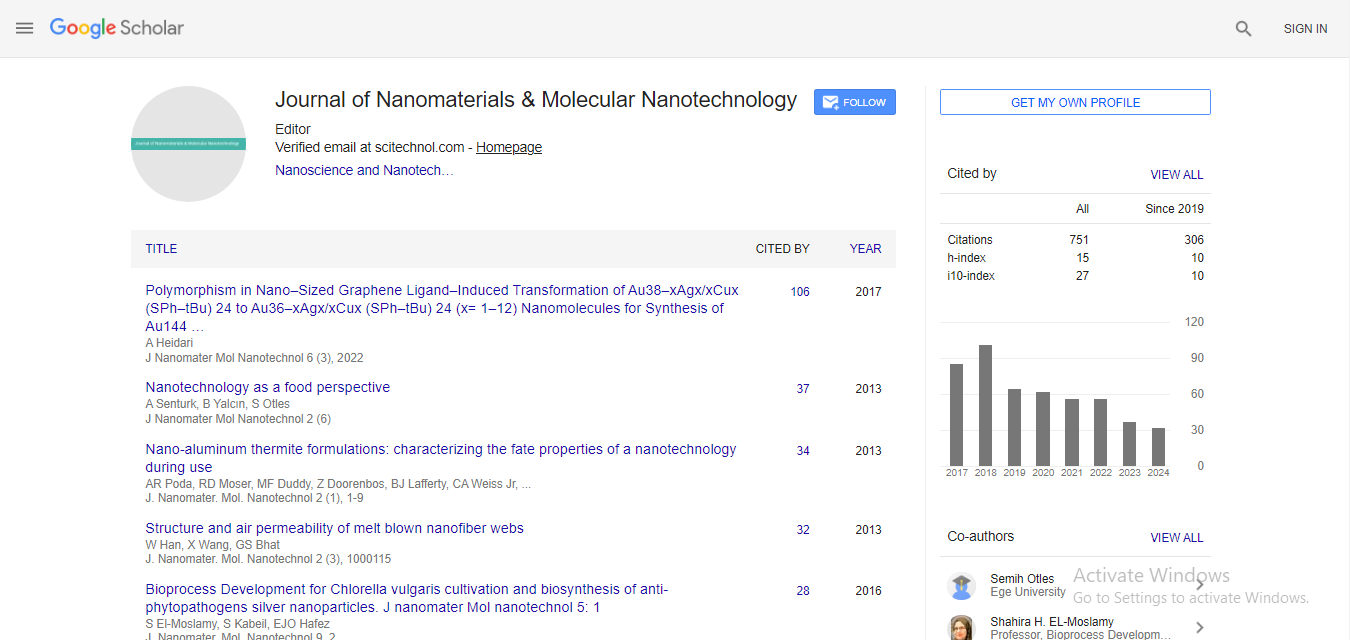Opinion Article, J Nanomater Mol Nanotechnol Vol: 11 Issue: 1
Green Nanotechnology and Nanoarchitectonics: An Overview
Wendi Lu*
Department of Materials Engineering, The Australian National University, Canberra, Australia
*Corresponding author: Wendi Lu
Department of Materials Engineering, The Australian National University, Canberra, Australia
E-mail: luwendi@gmail.com
Received date: 20 December, 2021, Manuscript No. JNMN-21-58131;
Editor assigned date: 22 December, 2021, PreQC No. JNMN-21-58131 (PQ);
Reviewed date: 05 January 2022, QC No. JNMN-21-58131;
Revised date: 12 January, 2022, Manuscript No. JNMN-21-58131 (R);
Published date: 19 January, 2022, DOI: 10.4172/2324-8777.2022.11(1).1000319
Citation: Lu W (2022) Green Nanotechnology and Nanoarchitectonics: An Overview. J Nanomater Mol Nanotechnol 11:1.
Keywords: Nanotechnology
Description
ifferent macromolecules and inorganics, management structures and functions of all biological onerous and soft tissues in organisms. Molecular biomimetic is Associate in Nursing rising field within which hybrid technologies area unit developed by mistreatment the tools of biological science and engineering. Taking lessons from biology, polypeptides will currently be genetically built to specifically bind to choose inorganic compounds for applications in Nano and biotechnology. This review discusses combinatorial biological protocols, that is, microorganism cell surface and phage-display technologies, within the choice of short sequences that have affinity to (noble) metals, semi conductive oxides and different technological compounds. These genetically built proteins for inorganics are often employed in the assembly of practical nanostructures. Supported the basic principles of molecular recognition, self-assembly and deoxyribonucleic acid manipulation, we tend to highlight flourishing uses of GEPI in engineering.
Properties of Nanostructures
Nanotechnology has been centered on new ideas and basic analysis to get nanoparticles at high rates. The work has enclosed contributions on basic physics and chemistry for nanoparticle generation with tailored properties via totally different artificial strategies. the foremost active nanoparticle analysis activities within the world embody basic studies for generation, processing, characterization, and modeling; investigations on magnetic nanoparticles; studies on argentiferous and composite particles; studies on particle mixture properties of metal, metal/polymer and chemical compound particles and self grouping techniques. Preparations of nanoparticles have yielded synthesis strategies that area unit wide wont to get nanoparticle samples for analysis functions. These preparations have LED to the elaborated examinations of the opto-electronic properties of nanostructures as they deviate from those of the majority material. Scanning probe research has detached the new world of engineering for observant and manipulating individual atoms and molecules on solid surfaces.
Nanotechnology has been wide studied for its potential to advance the sphere of biotechnology and medical analysis. Restrictive agencies like the agency have set to manage the rising field of engineering through existing legislative arrangements. the choice to refrain from introducing nanospecific restrictive policies looks to be geared toward encouraging safe and effective innovations by avoiding superfluous restrictive hurdles. because the engineering advances and additional scientific info becomes offered concerning its potential advantages and undesirable consequences, additional rigorous governance could also be required sure enough product varieties to safeguard the general public health. What’s needed to make valuable restrictive policies area unit coordinated international communications and data sharing between tutorial, industry, and government entities that area unit involved with engineering. this might facilitate accountable development of nanomaterial’s that would doubtless prolong and enhance the human lives.
Nanotechnology deals with the assembly and use of materials with nanoscale dimensions in several aspects of life. Nanoparticles, because of their nanoscale dimensions, have high surface-to-volume ratios and so terribly specific properties. Engineering could be a new and increasing technology, its main applications area unit the event of innovative strategies to fabricate new merchandise, to formulate new chemicals and materials, and to substitute the present generation instrumentation of apparatus with improved performance equipment, leading to a lower consumption of materials and energy and shriveled damage to the atmosphere, also giving environmental correction. This chapter reviews the applications of engineering in animal, agricultural, nutritionary, medicinal, and pharmaceutical sciences, also in contact action and environmental correction. The chapter provides descriptions of the foremost current applications of engineering that influence totally different aspects of human life.
Nanomaterial morphology plays a crucial role in deciding the effectiveness of mechanical reinforcement. Nanomaterial’s area unit higher reinforcing agents than 1D or 2D nanomaterial. It's been according that 2nd nanomaterials not solely have larger expanse compared to 2D and 1D nanomaterials, they're simpler in increasing the cross-linking density of chemical compound composites, thereby leading to important will increase in many mechanical properties like compression strength, enduringness, creep strain, and fracture toughness have compared the efficacies of varied 1D and 2nd carbon and inorganic nanomaterials as reinforcing agents for PPF chemical compound employed in bone-tissue engineering. Their results recommend that inorganic nanomaterials area unit higher reinforcing agents than carbon nanomaterials and generally 2nd nanomaterials area unit higher reinforcing agents than 1D nanomaterial.
Synthesis Procedure
Nanomaterial-based methods will overcome barriers sweet-faced by ancient antimicrobials, as well as antibiotic resistance. Nanomaterials containing antimicrobials will promptly be utilized as antiseptics also as disinfectants for external use in ex vivo operations. The fabric structure is often custom to accomplish most property toward microscopic organisms. Nanomaterials show a sturdy capability to cure external skin diseases, incorporating healing organic layers. Nanomaterials have emerged as new tools that to combat deadly microorganism infections. During this chapter, we tend to highlight the various nanomaterial-based approaches to eliminate microorganism infections, providing crucial insight into the look components that play important roles. Nanomaterials got to migrate a protracted distance from nose-to-brain, and so, they need a drive for his or her quality. Such quality is often provided to the nanomaterials by the surface modifications in them by ligands, particularly cellpenetrating peptides, which may enhance the quality of each the nanomaterials also as payload. The surface modifications are often done to reinforce the chemistry characteristics of the nanomaterials like mucoadhesive nature, penetration-enhancing property to push the drug delivery to the brain. Nanomaterial purity is additionally a crucial thought as residual contaminating metals may very well be to blame for genotoxicological responses instead of the particular nanomaterial itself, the amount of that area unit dependent upon the synthesis procedure used. Though postproduction process removes most of those metal catalysts, even refined nanomaterials should contain up to fifteen residual metals by mass. Whereas researchers have created encouraging tries to purify the nanomaterials below investigation so as to rule out the consequences of impurities on the discovered toxicity, usually the damaging effects of the purification method are unmarked. Metal nanomaterials have attracted abundant analysis attention because of their important prospects in clinical applications, like macromolecule detection, macromolecule assay, drug delivery, etc. specially, the applying of macromolecule assays has drawn increasing attention due to their outstanding performance in biosensor configuration. Normally, the performance of MNMs-based macromolecule assays depends on specific interactions between MNMs and therefore the proteins. These interactions are often quantified by signal modulation that reflects the precise concentration of the proteins of interest. To attain this goal, interface functionalization is important, that drives the stabilization.
 Spanish
Spanish  Chinese
Chinese  Russian
Russian  German
German  French
French  Japanese
Japanese  Portuguese
Portuguese  Hindi
Hindi 



